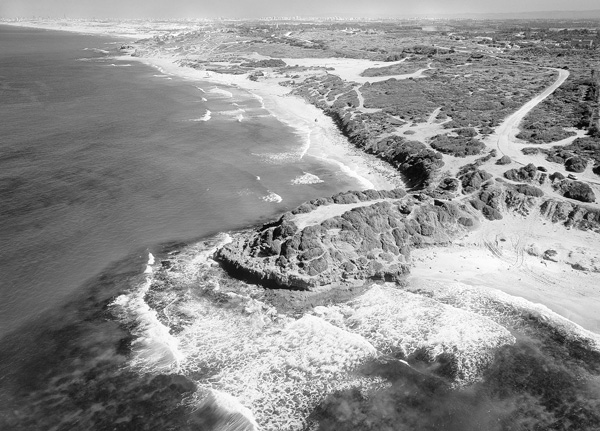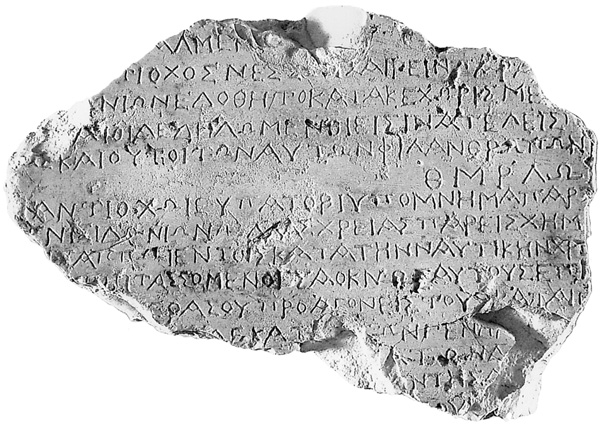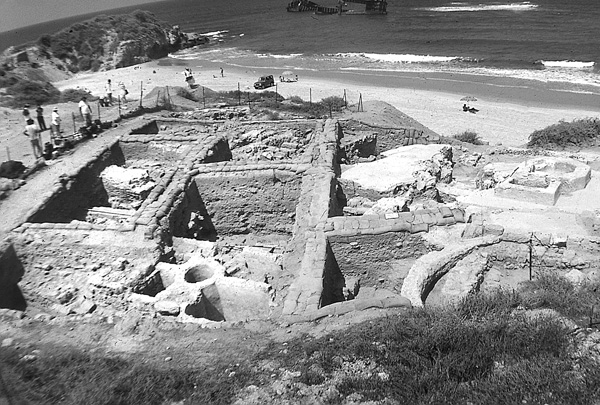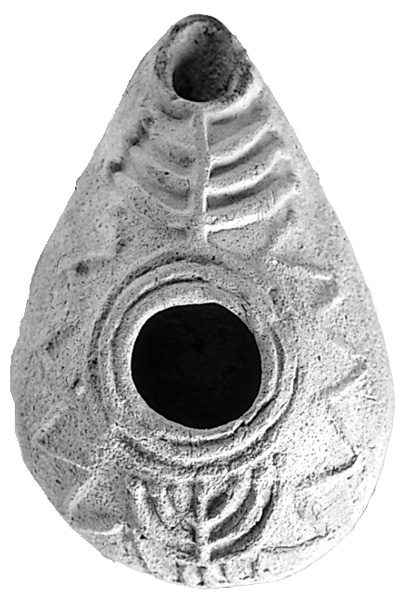Yavneh-Yam
IDENTIFICATION
Yavneh-Yam (Iamnia-on-the-Sea; Khirbet edh-Dherbeh) is located on the Mediterranean coast, roughly midway between Jaffa and Ashdod, along a natural anchorage. In the nineteenth century the site was visited by E. G. Rey (1859), V. Guérin (1863), F. G. D. Bedford (1863), C. Warren (1867), C. R. Conder and H. H. Kitchener (1875), and L. C. Clermont-Ganneau (1874 and 1881). V. Guérin was the first to identify the site with the port of Iamneia, which he referred to as Maiumas Iamniae, though such a name does not occur in ancient sources. The site is mentioned in various sources, such as the el-Amarna letters (fourteenth century BCE), where it is called muhazi (harbor); Greek, Latin, Aramaic, and Arabic sources call it “the harbor of Iamnia” (Yavneh), such as Iamniton limen (Ptolemy, Geography V, 16, 2), mahouza d’Yamnin (Vita Petri Iberi 123), maoza d’Yamnias (Johannes Rufus, Plerophoriae 76), mao(u)za Iamnias (ACO III: 38

EXCAVATIONS
A. Reifenberg’s (1950) first aerial photographs of the site were followed by M. Dothan’s (1952) archaeological survey. The first archaeological excavations at Yavneh-Yam were carried out by J. Kaplan in 1966–1969 in the eastern ramparts and the monumental “triple gate,” which he attributed to the Middle Bronze Age IIA. Kaplan assumed that the enclosure was a square, 800 by 800 m, the western section of which had been eroded by the sea; but this has been disproved by recent underwater surveys. Several salvage excavations carried out by the Israel Antiquities Authority between 1968 and 1992 within the area of the site and its vicinity, including underwater surveys, have revealed remains from the Neolithic period to the Early Islamic period. Monumental structures from the Byzantine period, among which was an elaborate mosaic pavement, were unearthed between areas A and B. Many of these finds, including those of the Tel Aviv University excavations, are on display in the museum at Kibbutz
| IIB | Early Islamic | 7th–8th CE | + | + | ||
| III | Byzantine | 5th–7th CE | + | + | + | |
| IV | Late Roman | 4th CE | + | |||
| V | Early Roman | 1st CE | + | |||
| VI | Hellenistic | 3th–2nd BCE | + | + | + | |
| VII | Persian | 5th–4th BCE | + | + | ||
| VIII | Babylonian | first half of 6th BCE | + | |||
| IX | Iron IIB–C | second half of 7th BCE | + | + | + | |
| X | Iron II | 8th BCE | + | + | ||
| XI | Late Bronze II | 14th–13th BCE | + | + |
EXCAVATION RESULTS
THE LATE BRONZE AGE TO THE BABYLONIAN PERIOD. Remains of the Late Bronze Age II are so far limited to ceramic finds, such as fragments of white slip ware and milk bowls, which were retrieved mainly from among mud bricks of stratum IX. Iron Age II remains were encountered in areas A and C. In area C, a segment of a massive wall, c. 2 m thick, has been uncovered, probably representing the fortification wall of the settlement from the tenth/ninth to the eighth/seventh centuries BCE.
Remains of a monumental structure were uncovered in area A. Its walls are of ashlars with drafted margins arranged as alternating headers and stretchers; the upper courses were probably of sun-dried mud bricks, as is typical of Iron Age structures throughout Israel and indicated here by the rich brick debris covering the area. A channel crosses its walls and floor. Though the function of this structure cannot yet be clearly defined, it may have been an administrative building controlling the harbor area. The ceramic assemblage contains both local and imported East Greek pottery typical of the eighth and mainly late seventh centuries BCE. Wild Goat-style pottery, present at

THE PERSIAN AND HELLENISTIC PERIODS. Persian period remains were encountered in areas A and B. In area A, two walls creating an elongated courtyard, with smaller walls attached to them, were built over the leveled mud-brick debris of stratum IX. Both here and in the southwestern corner of area B are walls constructed in the Phoenician style, combining ashlar piers of local kurkar with fieldstone cores. Yavneh-Yam represents the southernmost extent of this construction method along the Phoenician-Palestinian coast. Finds include a large inventory of local and imported pottery. The local ware consists of the well-known repertoire of Persian period Palestine. Imported pottery includes amphorae and Attic-style black- and red-figured pottery of the fifth and fourth centuries BCE and some terracotta figurines of a Greek-Persian style. Milesian and Phoenician coins date to the fourth century BCE. Attic pottery in Persian period Yavneh-Yam seems to reflect intensive commercial ties with the Greek world, and raises the possibility of some form of Greek presence at the site.

The Hellenistic period at Yavneh-Yam is marked by a fragmentary Greek inscription, representing the correspondence between the Seleucid king Antiochus V Eupator and the citizens of Yavneh-Yam, indicating the month Loos of year 149 of the Seleucid calendar (June–July 163 BCE). It reads:

Letter A: “[King An]tiochus to Nessos, greetings. The recorded petition was submitted by [the Sid]onians [in the Port of Iamneia]. Since…the…referred to are [also] immune…so that they will also enjoy the same privileges. Farewell. Loos 149.”
Letter B: “Petition to [King] Antiochus Eupator from the Sidonians in the [Port of Iamneia]. Since [their ancestors] rendered many services to his grandfather, promptly obeying [all] instructions regarding the naval service…”

It seems that Yavneh-Yam’s Hellenized population was frightened by the Maccabean impetus, as can be corroborated easily with the passage from 2 Maccabees 12:9, 39–46, which states that Judah Maccabee “fell upon the Jamnites, too, by night and set fire to the fort and the ships, so that the glare of the flames was visible as far as Jerusalem, two hundred forty stadia away.” Even if disputable, this event reflects a general atmosphere prevailing at the time. Hellenistic period remains were found mainly in area A, consisting of reused walls and building material, now partly covered with painted plaster, sometimes including architectural decorations such as a fragment of a triglyph.
The pottery of stratum VI consists of imported fine/table ware, amphorae, and local, semi-fine, and everyday ware. The fine ware includes the main types of the Hellenistic repertoire. A large number of Hellenistic imported amphorae have been retrieved, as has one example of a locally made amphora bearing the name Aristokrates Agoranomos and the year 180 (133/132 BCE). An identical amphora comes from Hellenistic Shiqmona. A large number of murex shells have been found in this stratum, reflecting one of the main sources of income for which the Phoenicians became so famous. A terracotta statuette of a girl (hetaira) playing the harp and a glass pendant of Harpokrates seem to reflect the Hellenized character of the site as well. Judging from the finds and historical sources, it appears likely that Hellenistic Yavneh-Yam was destroyed by John Hyrcanus towards the end of the second century BCE.
THE ROMAN PERIOD. Few finds can thus far be attributed to the Early Roman period. They include Herodian lamps with a bow-shaped nozzle, discus lamps, chalk vessels, and four ossuaries from the Kaplan excavations, which point to a Jewish presence at the site. Remains of the Late Roman period, comprising a large building and water and sewage channels, have been identified in area B only. Some lamps of the Beit Natif type and a relatively large number of fourth- and fifth-century CE coins were retrieved among the remains of horrea paved in mosaics.
A revival of the site can be dated to the Byzantine period, mainly the fifth and sixth centuries CE, reflecting a peak in the Holy Land’s enjoyment of the economic advantages of pilgrimage. Segments of an elaborate mosaic pavement dated to the sixth century CE, which may have been part of a church, were found in area A. Monumental marble bases and columns and a marble bowl reused in Early Islamic structures may also have belonged to that structure.

Area B has yielded remains of a large bath complex, containing an octagonal basin surrounded by mosaic pavements (probably the frigidarium), and a water tower (castellum aquis) consisting of a central round shaft-like pool and four lateral square-shaped pools. All of these have plastered walls and mosaic pavements. Water was distributed from the central shaft to the adjacent pools via lead pipes.
Along the slopes to the coast, parts of mosaic pavements and plastered structures with remains of large pithoi have been partly unearthed. A funerary cave was excavated in 1995 in the eastern outskirts of the site, below the Bronze Age ramparts (area T). It was divided into several rooms. The walls of one of them were covered with plaster and frescoes depicting medallions containing crosses, one flanked by the Greek letters alpha and omega.
Yavneh-Yam became, in the mid-fifth century CE, the home of the monophysite bishop of Gaza, Peter the Iberian, as reported in his biography Vita Petri Iberi, which represents a valuable source for the history of the site.
THE EARLY ISLAMIC PERIOD. Two main phases of the Early Islamic period (stratum II) were discerned: phase IIB (Umayyad–Abbasid period, seventh to eighth centuries CE), and phase IIA (Abbasid–Fatimid period, ninth to eleventh centuries CE). Phase IIB is mainly visible in area B, among the remains of which are mosaic pavements incorporating the octagonal pool of the Byzantine bathhouse. During the later Islamic phase (phase IIA), building activity is evident mainly in areas A and C, when the naval fort of Minet Rubin (area C) was built. A strong square tower (c. 5 by 4.80 m) was preserved to a height of c. 5 m in this area; it probably belonged to those famous outposts (ribatat) which were part of the coastal defensive system, also serving the ransoming of prisoners, thus confirming sources naming Yavneh-Yam as
A rich pottery assemblage dates to phase IIA, to which coins and inscribed glass weights can also be assigned. Since no remains from the Crusader period could be attributed to the site, and only a few sporadic pottery sherds belong to the Mameluke period, the site appears to have been only sporadically inhabited after the eleventh century CE.
MOSHE FISCHER
IDENTIFICATION
Yavneh-Yam (Iamnia-on-the-Sea; Khirbet edh-Dherbeh) is located on the Mediterranean coast, roughly midway between Jaffa and Ashdod, along a natural anchorage. In the nineteenth century the site was visited by E. G. Rey (1859), V. Guérin (1863), F. G. D. Bedford (1863), C. Warren (1867), C. R. Conder and H. H. Kitchener (1875), and L. C. Clermont-Ganneau (1874 and 1881). V. Guérin was the first to identify the site with the port of Iamneia, which he referred to as Maiumas Iamniae, though such a name does not occur in ancient sources. The site is mentioned in various sources, such as the el-Amarna letters (fourteenth century BCE), where it is called muhazi (harbor); Greek, Latin, Aramaic, and Arabic sources call it “the harbor of Iamnia” (Yavneh), such as Iamniton limen (Ptolemy, Geography V, 16, 2), mahouza d’Yamnin (Vita Petri Iberi 123), maoza d’Yamnias (Johannes Rufus, Plerophoriae 76), mao(u)za Iamnias (ACO III: 38
